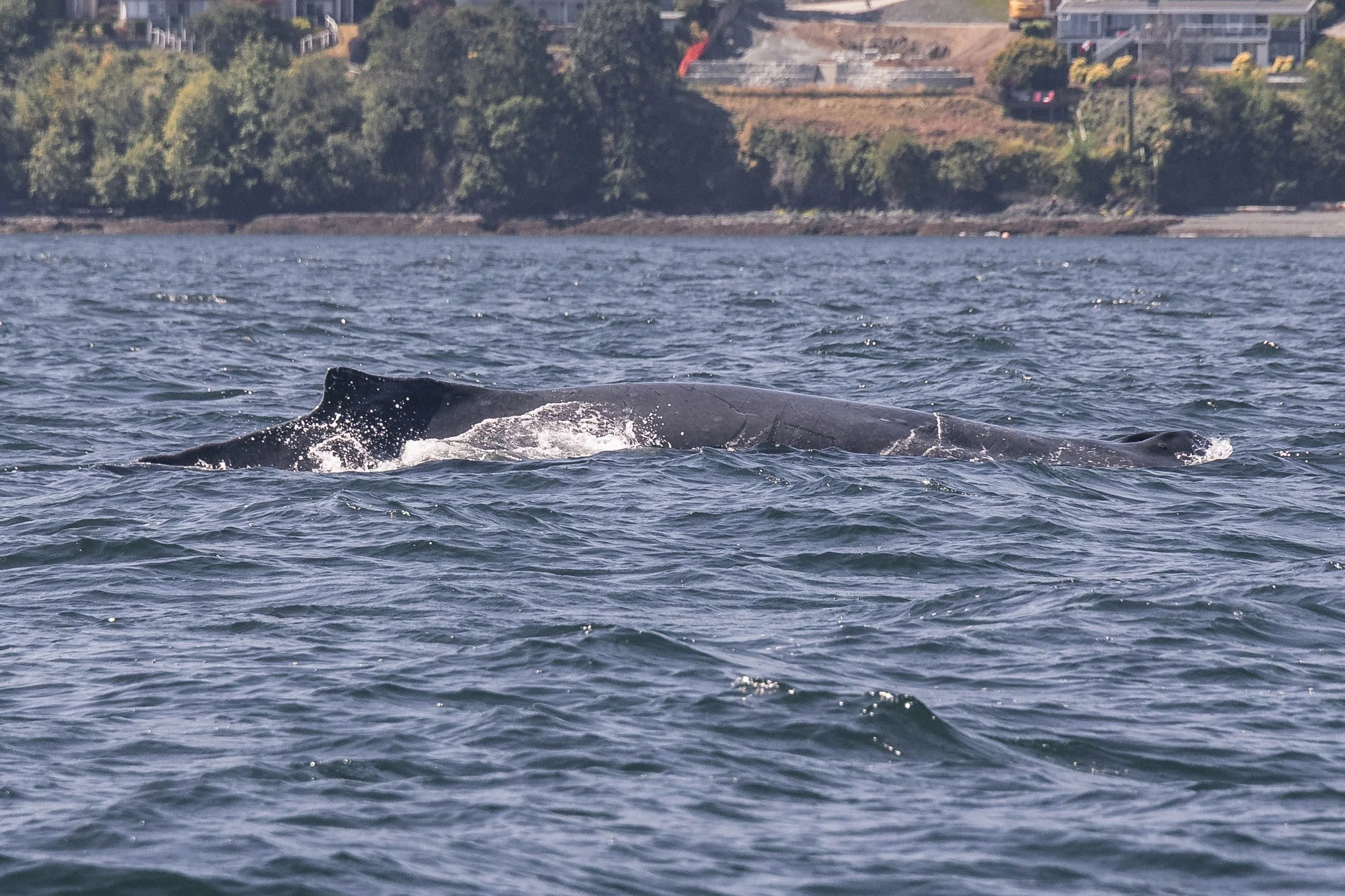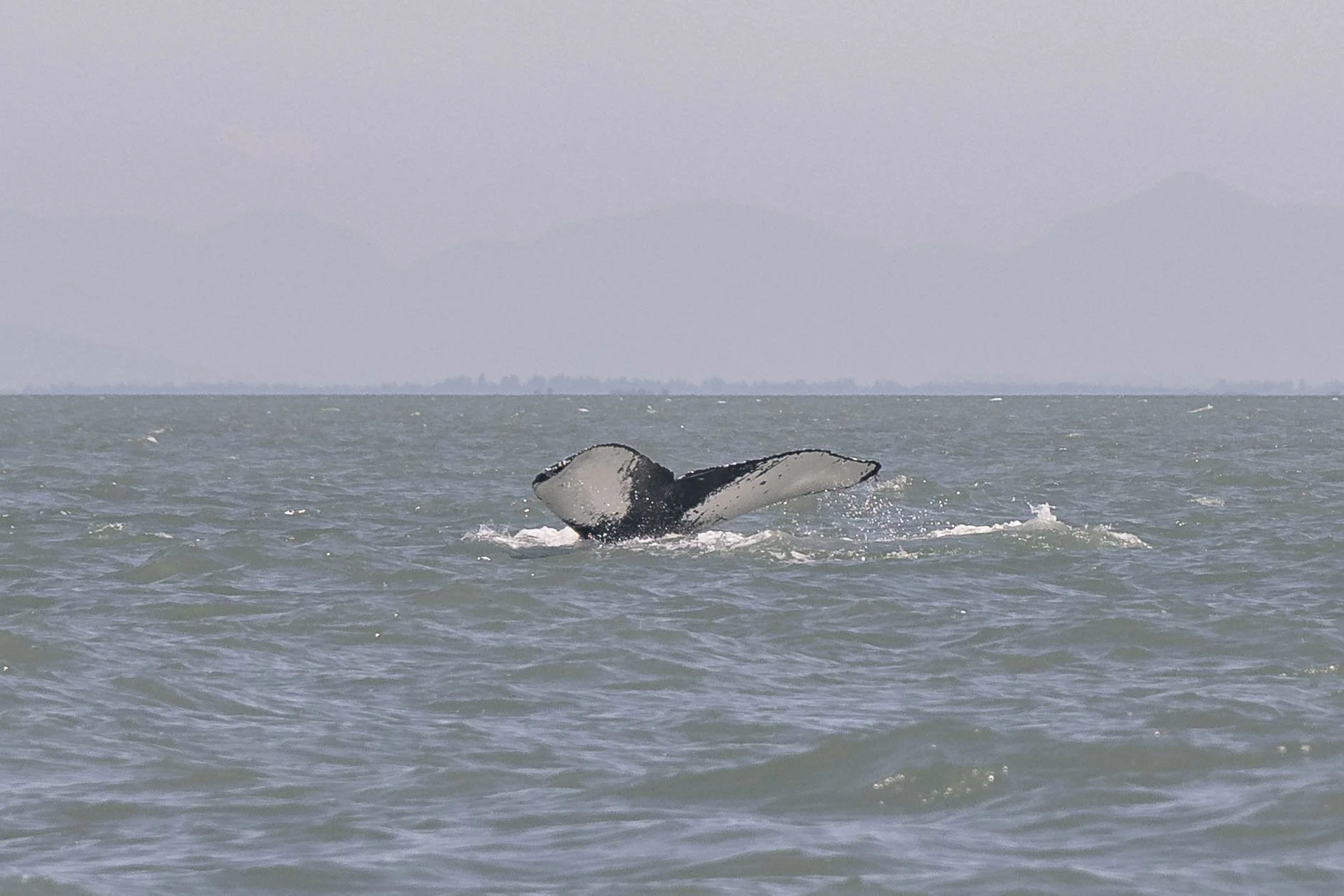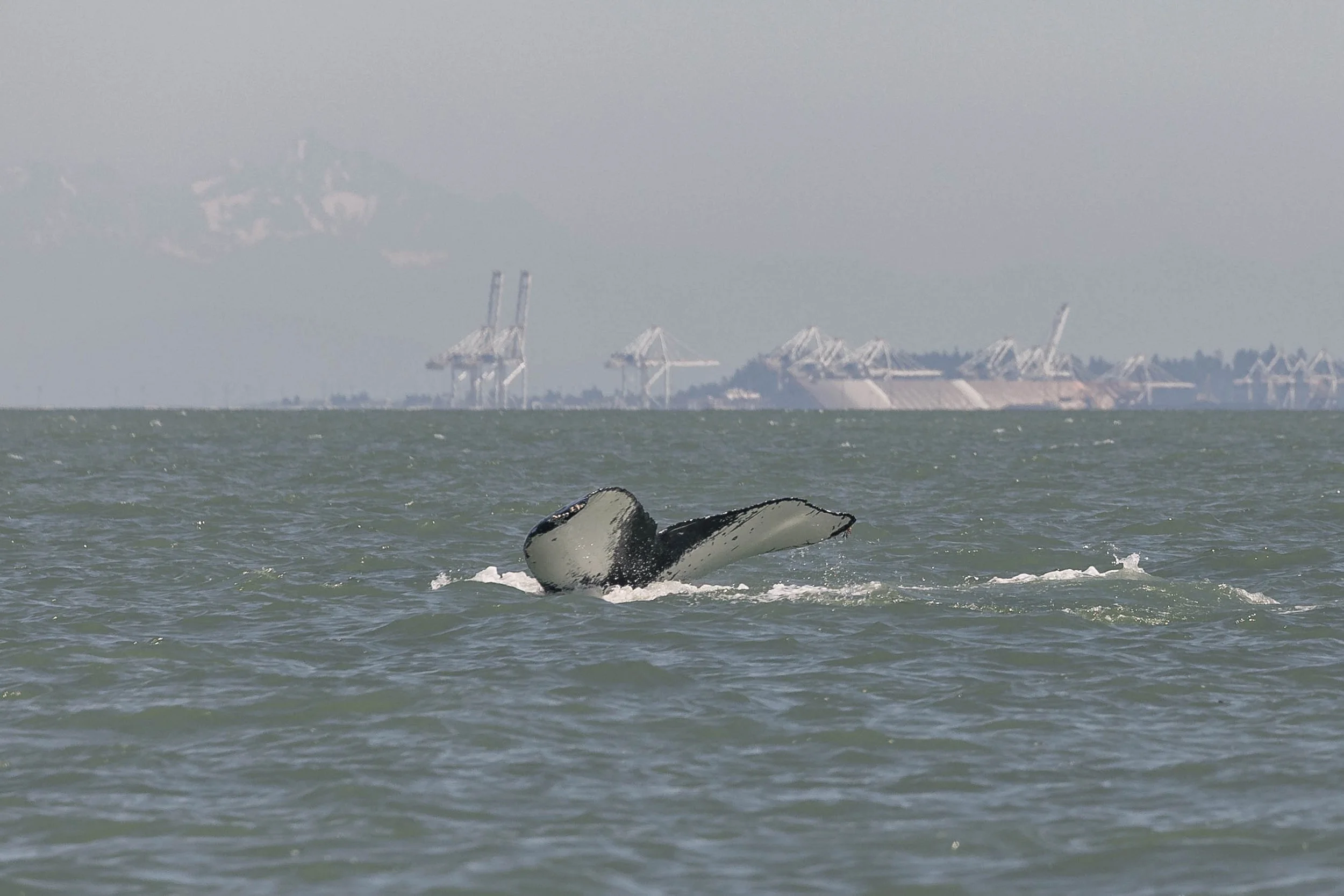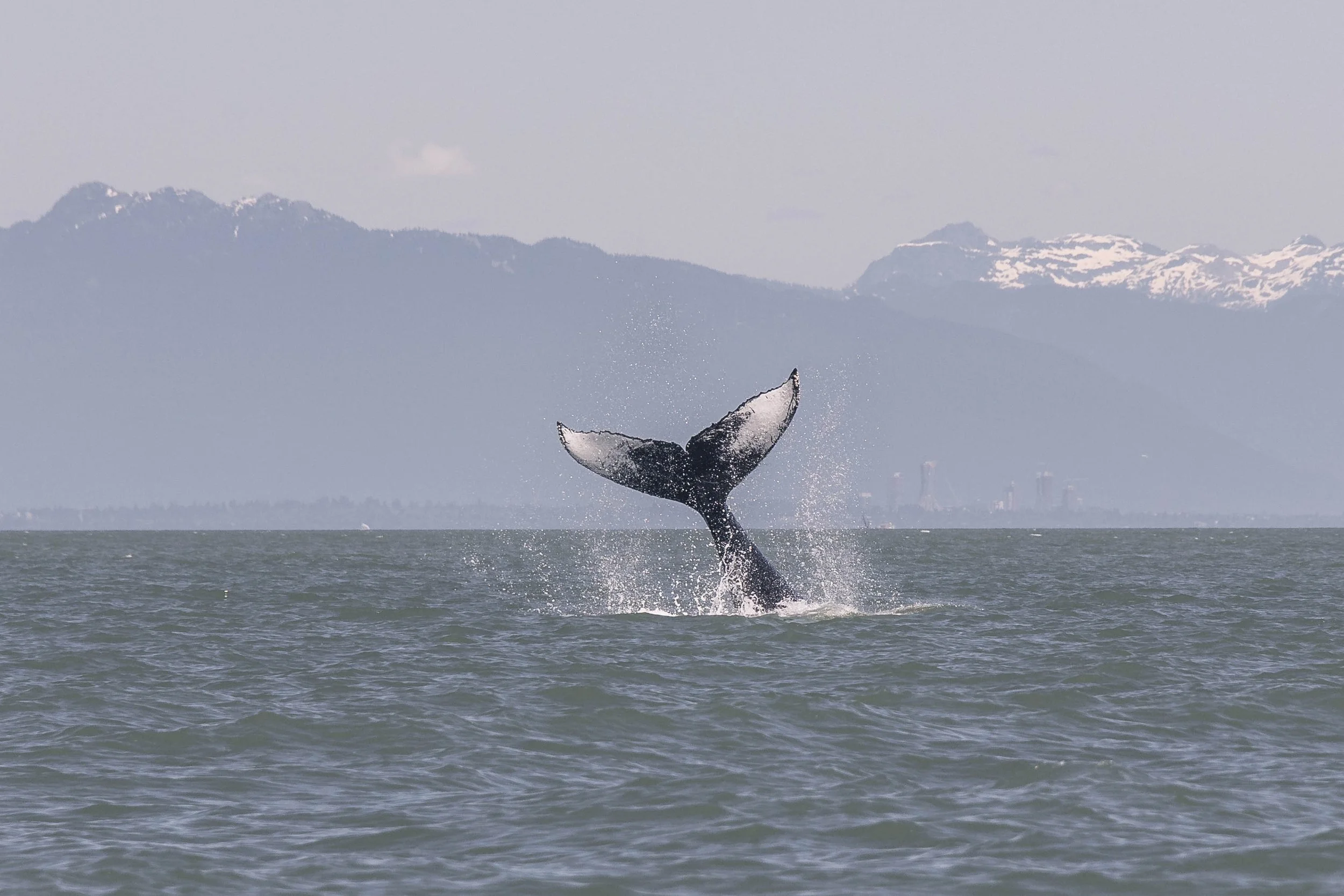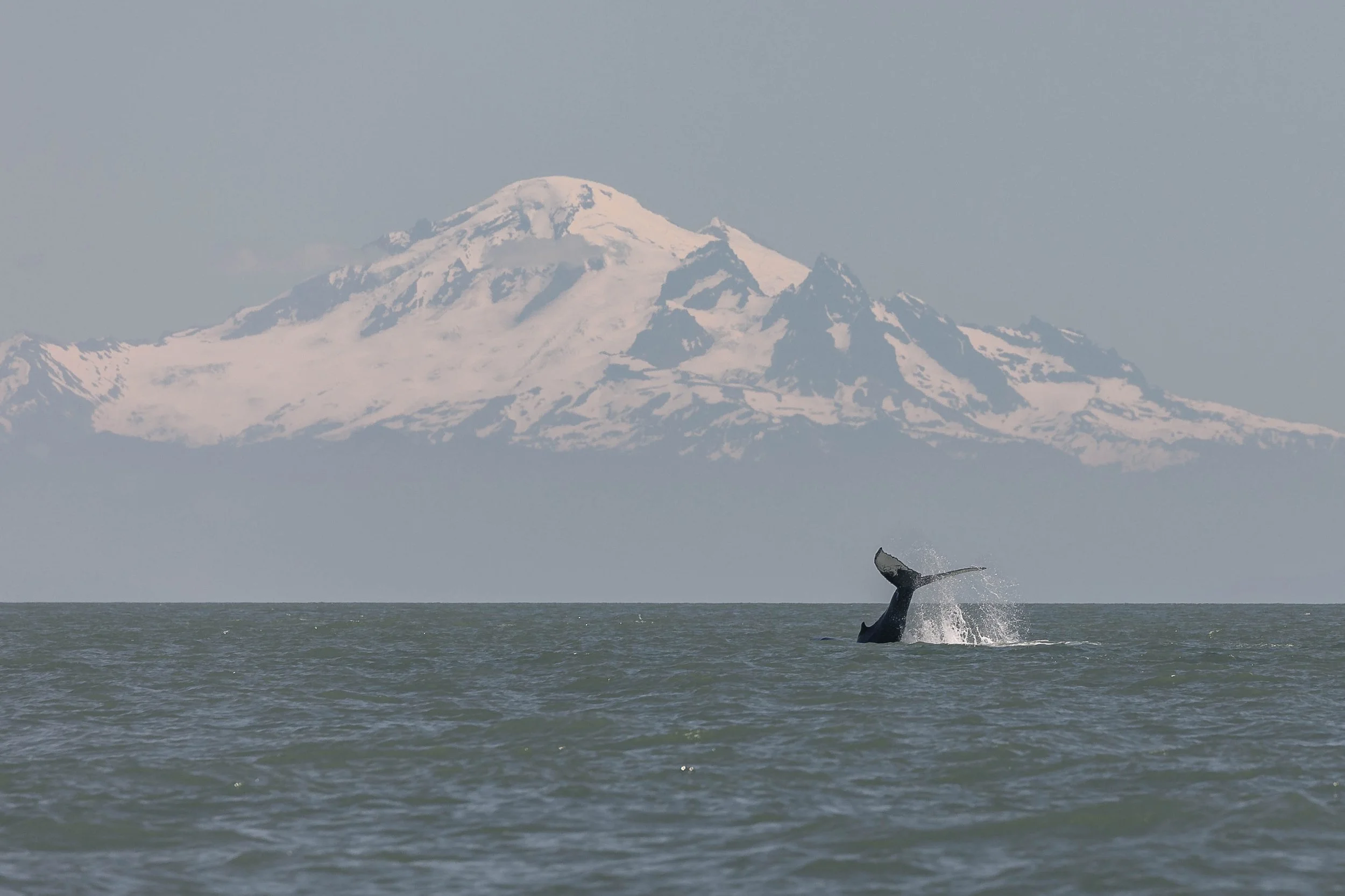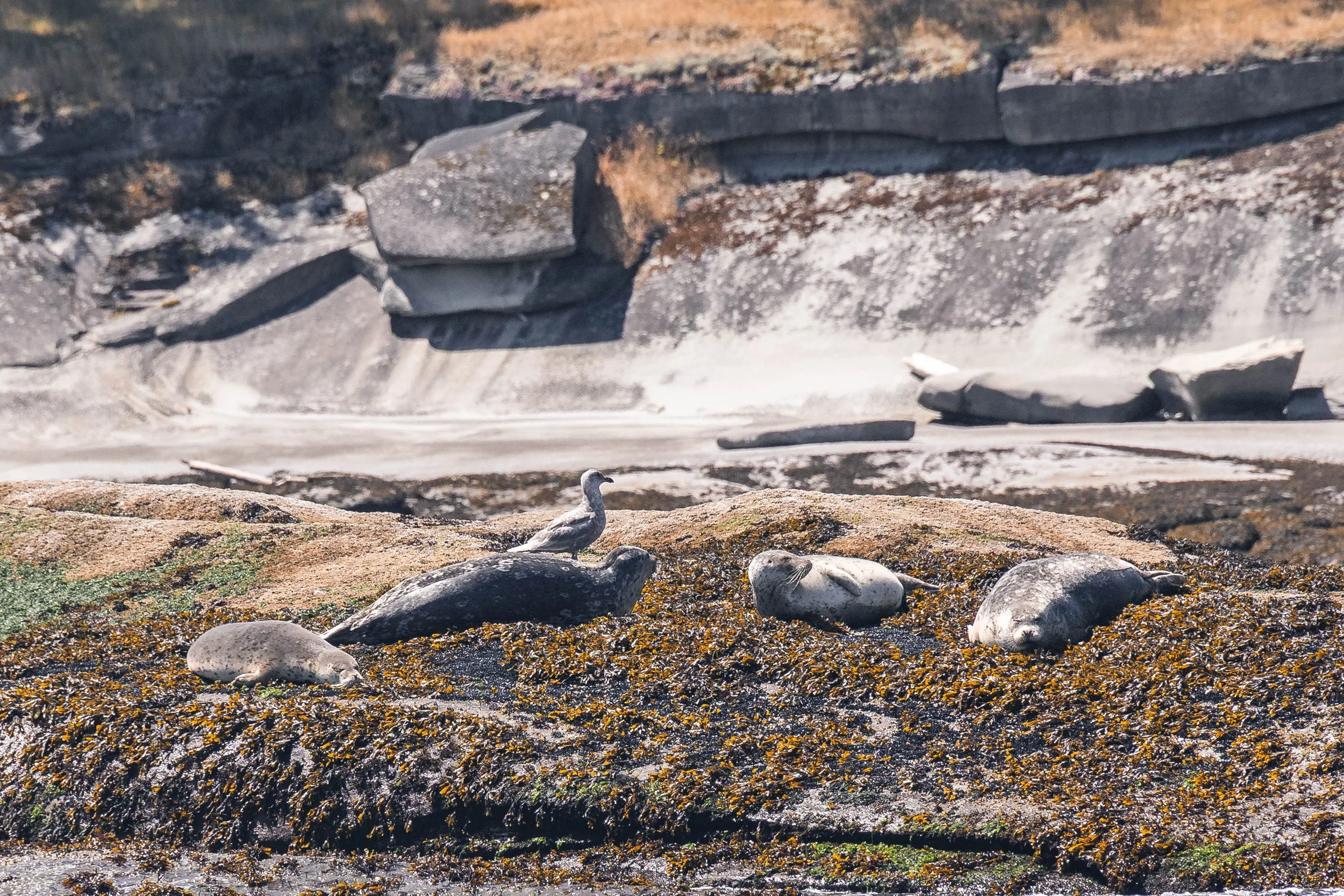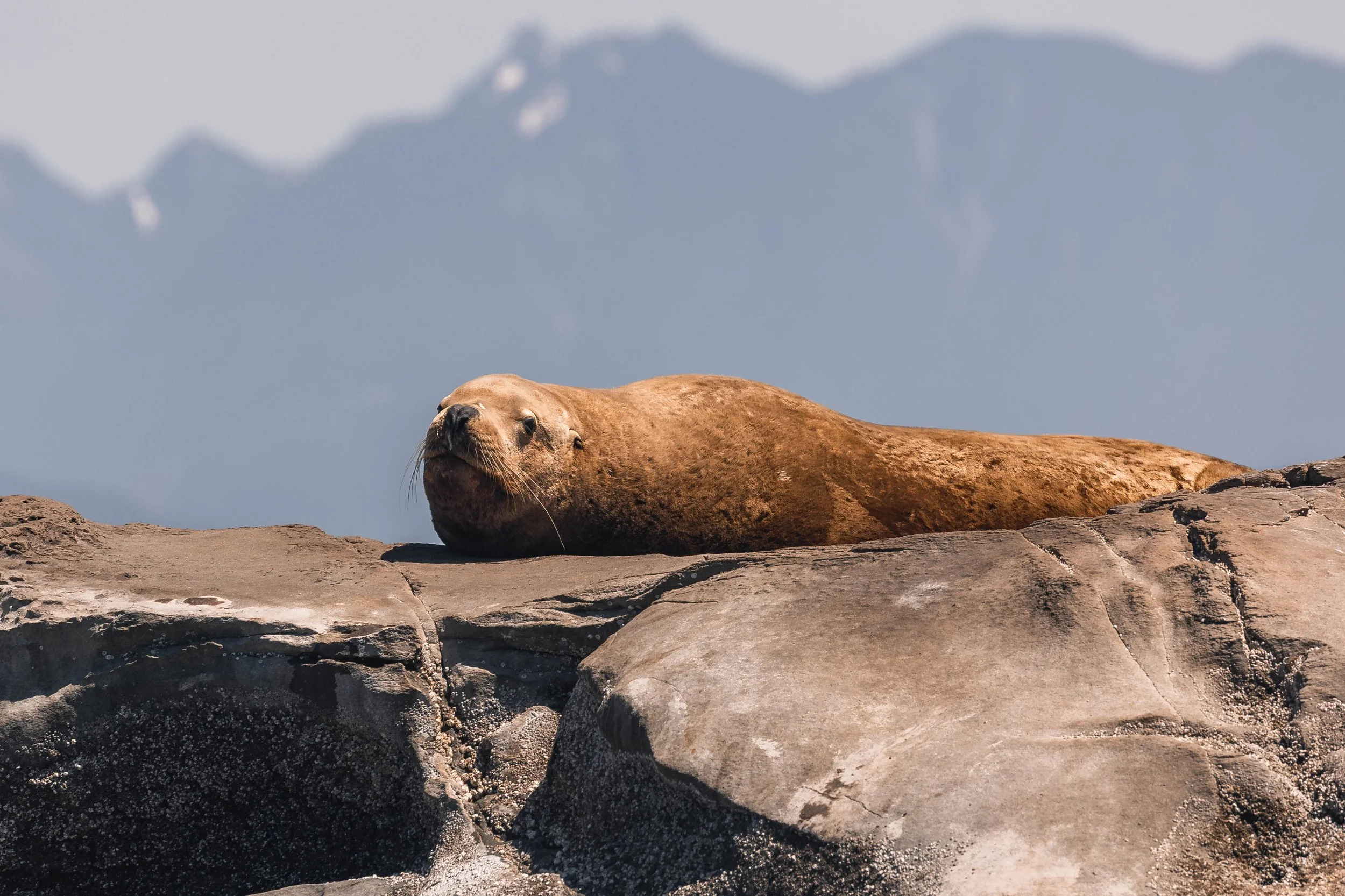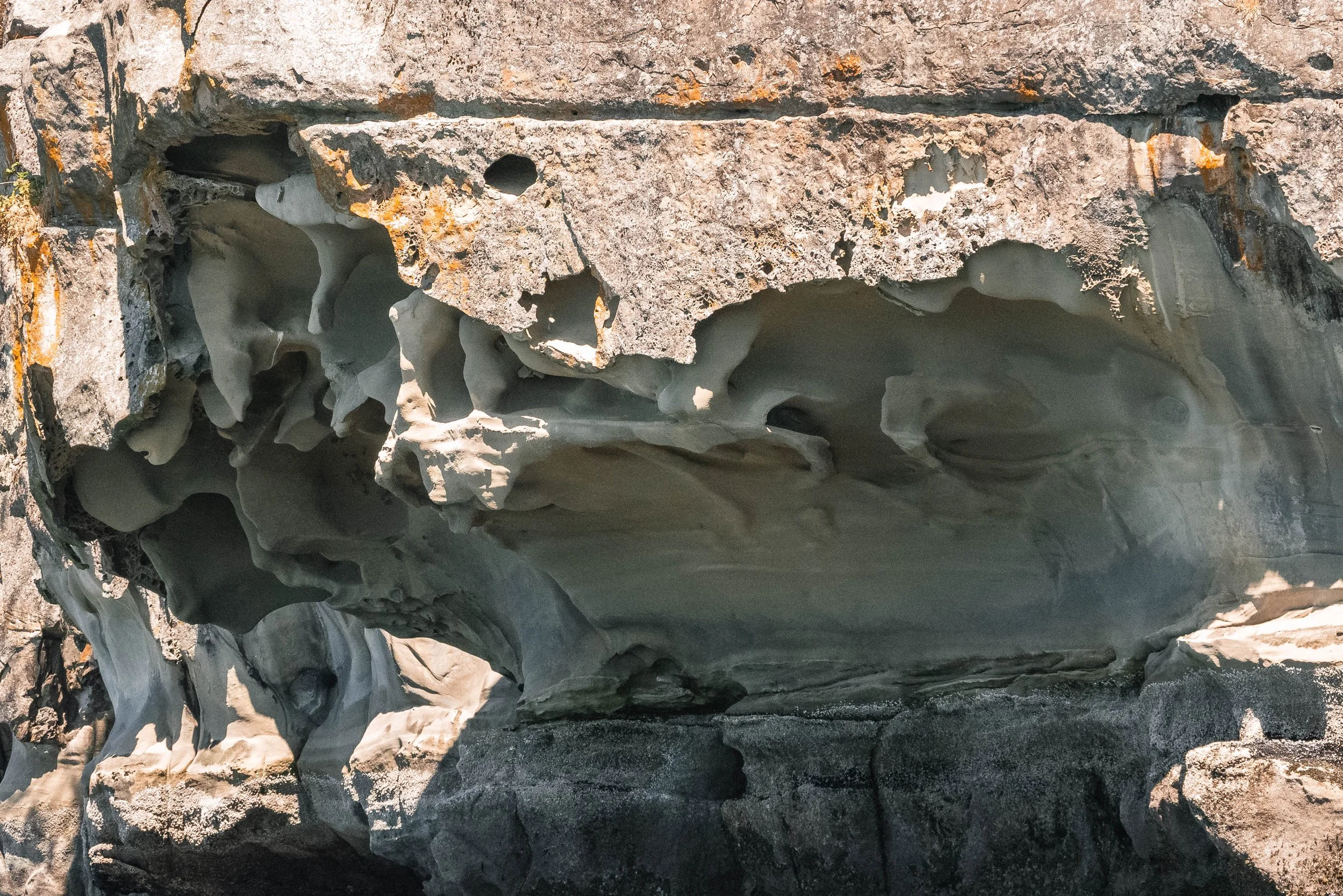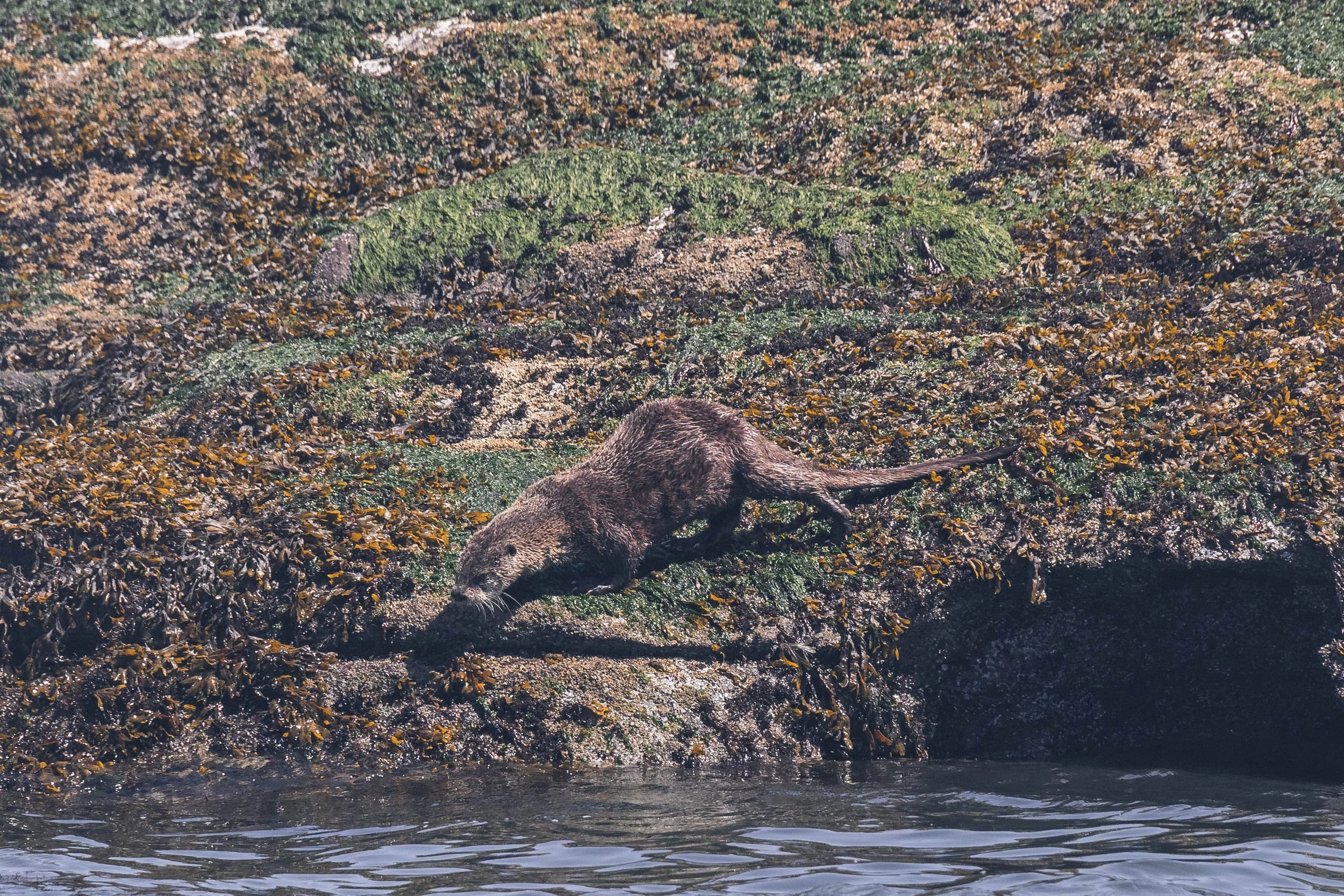June 29, 2025, 10:30 AM - Tails in the sun!
We pushed off the dock this morning with excitement, the sun was shining, and the temperature was perfect to pile onto a boat to keep cool! We sent Kula our semi-covered vessel one way and our open boat, Cascadia, the other to maximize our chances of spotting whales! Out here in the Salish Sea, none of the whales we encounter are tagged, chipped or tracked, and that’s very intentional. While tracking technology has provided valuable insights into whale migration and behaviour in the past, the practice of tagging large whales has largely fallen out of favour due to its invasive nature and long-term impacts on the animals.
Earlier methods of tagging involved using satellite transmitters embedded into the whales’ blubber, which were often fired using a crossbow-like device. These tags were designed to stay on for weeks or even months, transmitting vital location data to researchers. But over time, we began to notice something troubling. Once the tags fell off or were forcibly shed, they often left behind visible scars and, in some cases, long-term tissue damage. For a highly intelligent and socially complex animal like a whale, the intrusion of a large foreign object can have physical and potentially behavioural consequences.
Today, the marine science community, including organizations along our coast, have largely moved away from tagging in favour of more non-invasive techniques. Photographic identification (photo-ID) has become our most valuable tool. By documenting unique markings on a whale’s tail fluke or dorsal fin, we can recognize individuals year after year, no need for contact or disturbance. This method allows us to track migration, social groupings, and health over time, all while keeping the whales wild and free.
Speaking of wild, we spotted a big blow in the Strait, it was one of our humpbacks! Out came our telephoto lenses to snap some photos of their tail and dorsal fin to get an identification! Each humpback whale has a unique pattern on the underside of its tail fluke, much like a human fingerprint. By capturing a clear photograph of the tail when the whale dives, we’re able to identify individuals and follow their journeys year after year without ever needing to tag them.
Once we’ve snapped a good photo of a fluke, the next step is comparing it to ID catalogues, both regional and coast-wide. We primarily use the KETA catalogue, as well as Happywhale, an international platform that utilizes AI to help match whale flukes worldwide. These catalogues contain thousands of images, each one linked to a known whale with a unique ID number and often a nickname. If we find a match, we can learn a great deal about the whale’s history, where it’s been seen, who it’s been travelling with, and how often it returns to our waters.
This method of identification is not only effective, but it also allows us and researchers to build relationships with these whales over time. Names like Wisp (BCY1464), the whale we identified in this encounter, become more than just entries in a database; they represent individuals with stories, scars, calves, and personalities. Through respectful distance and a good camera lens, we’re able to learn so much while allowing these wild animals to remain just that, wild. After we spent some time with Wisp, we left them to their travels and continued to scan the waves to see who else we might spot.
We decided to head south next, and we are happy we chose this route because we had a gentile giant surprise. This time, we had a bit of a humpback party going on. Malachite (BCY1463), Moresby (KEY0055 ), Mammoth/Ocean (BCX1710), Beak (BCX1606) and Neptune (BCY1021) were splashing around near Galiano Island. Humpback whales are known for their spectacular surface behaviours, which are not only breathtaking to witness but also believed to play an important role in communication. One common behaviour is fluking, where a whale arches its back and lifts its tail fluke high out of the water before a deep dive. This movement is often a signal that the whale is about to go foraging or dive for an extended period. Another dramatic behaviour is the cartwheel, where a humpback throws its tail high into the air and rotates sideways, sometimes slamming it down with force. This can create a massive splash and may be used as a form of display or to communicate excitement, agitation, or dominance.
Perhaps one of the most striking behaviours is tail slapping, where the whale repeatedly smacks its tail against the surface of the water. This action sends loud, low-frequency sounds through the ocean that can travel great distances. Scientists believe these behaviours are a form of non-vocal communication, allowing humpbacks to relay messages across vast stretches of water. Whether it’s to signal location, coordinate movement, assert social standing, or even warn others of nearby threats, these dramatic movements are part of a complex system of interaction within humpback communities. After getting to witness our humpbacks having a ton of fun, we got to meet a few more members of the Salish Sea.
Out on the Salish Sea, we’re lucky to regularly encounter a variety of fascinating marine wildlife beyond the whales, including Steller Sea Lions, harbour seals, and cormorants. Steller Sea Lions are the largest sea lion species in the world, with males weighing in at over 2,500 pounds! During the summer months, many of the big males have returned from their breeding rookeries in Alaska and Northern B.C, and we often see them hauled out on rocky outcrops, bellowing loudly and jostling for the best sunning spots. Their deep, roaring vocalizations are hard to miss!
Sharing the coastline are harbour seals, which are much smaller and quieter, often seen lounging like spotted sausages along the shoreline. Unlike sea lions, they lack external ear flaps and aren’t as mobile on land, but they’re incredibly agile swimmers. Fun fact: every harbour seal has a unique pattern of spots, kind of like a fingerprint! Meanwhile, perched on rocky cliffs or pilings, you’ll often spot cormorants, long-necked, diving seabirds with striking turquoise eyes and glossy black feathers. These birds can dive over 100 feet deep to chase fish, and because their feathers aren’t fully waterproof, you’ll frequently see them standing with wings outstretched to dry. Each of these animals plays a vital role in the coastal ecosystem, and seeing them in their natural habitat is always a special treat.
After an afternoon full of wildlife and sunshine, it was time to head back to the harbour!
Enjoy the photos below taken by Desarae Poier, Hayleigh Hilbert and Jordan Robinson.
Wisp’s dorsal. Photo by Hayleigh Hilbert.
Wisp fluking. Photo by Hayleigh Hilbert.
Wisp. Photo by Jordan Robinson.
Wisp arching to dive. Photo by Jordan Robinson.
The underside of Wisp’s tail. Photo by Jordan Robinson.
Beak. Photo by Hayleigh Hilbert.
Beak’s dorsal. Photo by Desarae Poier.
An intresting angle shot of Beak. Photo by Desarae Poier.
A fluke waterfall from Beak. Photo by Desarae Poier.
Beak flukig. Photo by Desarae Poier.
Neptune’s dorsal. Photo by Hayleigh Hilbert.
Neptune’s flukes. Photo by Hayleigh Hilbert.
Neptune going for a dive. Photo by Desarae Poier.
Malachite tail slapping. Photo by Hayleigh Hilbert.
Malachite. Photo by Hayleigh Hilbert.
Malachite splashing up a storm in front of Mt. Baker. Photo by Desarae Poier.
Kula. Photo by Hayleigh Hilbert.
Keta. Photo by Hayleigh Hilbert.
Cascadia. Photo by Jordan Robinson.
Harbour seals sharing the rocks with a gull. Photo by Hayleigh Hilbert.
Chubby harbour seals. Photo by Jordan Robinson.
Going in? Photo by Jordan Robinson.
A fuzzy Steller Sea Lion. Photo by Desarae Poier.
Check out ths size difference! Photo by Jordan Robinson.
A good time for a nap for these Stellers! Photo by Hayleigh Hilbert.
A bald eagle soars overhead. Photo by Jordan Robinson.
An eglet in the nest. Photo by Jordan Robinson.
A bald eagle raiding the cormorants nests. Photo by Jordan Robinson.
A cormorant in its nest. Photo by Jordan Robinson.
The rock formations at the bluffs. Photo by Jordan Robinson.
The Gabriola Bluffs. Photo by Jordan Robinson.
A river otter. Photo by Hayleigh Hilbert.
A couple river otters on the dock. Photo by Hayleigh Hilbert.






